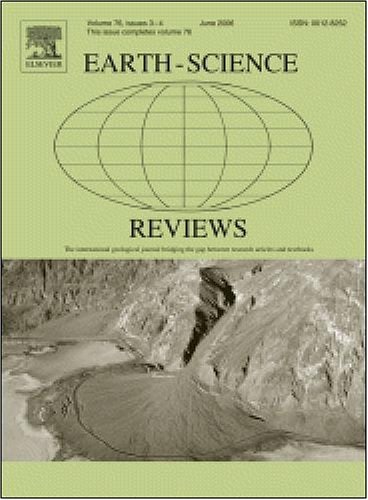Measures of prehistoric terrestrial net ecosystem productivity and carbon sink function
IF 10
1区 地球科学
Q1 GEOSCIENCES, MULTIDISCIPLINARY
引用次数: 0
Abstract
Indicators of past biological productivity, or ‘palaeoproductivity proxies’, offer ways to indirectly measure key aspects of Earth's deep-time ecosystem and carbon cycle functioning. Given that plants have been the principal primary producers on land for hundreds of millions of years, the abundances of fossil plants in the rock record can indicate past ‘net terrestrial ecosystem productivity’ (NTEP). This is the net carbon storage or release by a terrestrial ecosystem, and a measure of whether an ecosystem is a carbon sink or source. When applied on a global scale, NTEP represents a major component of Earth's carbon cycle. Moreover, since plants are particularly sensitive to rapid climatic events, measuring NTEP with fossil plants should indicate how land carbon sinks have been impacted by these climatic changes. Herein, we compare and contrast three potential proxies of NTEP changes in deep time: total organic carbon (TOC), terrestrial organic microfossil concentrations () and terrestrial organic carbon (TrOC). However, the preservation pathways of terrestrial organic microfossils (hence, and TrOC) are complex and poorly understood. In this review, we have: 1, adapted and applied a framework of modern net ecosystem productivity (NEP) to prehistoric settings by incorporating post-burial effects; 2, summarized the factors that influence the preservation and accumulation rates of land-derived organic carbon in the fossil record; and 3, explored the conditions under which and TrOC may provide valid estimates of prehistoric NTEP. Given their specificity, we conclude that the fossil-based metrics ( and TrOC) hold greater potential than TOC as proxies of NTEP. Moreover, and TrOC can be readily applied to the rock record to estimate the relative changes of past NTEP, if several key parameters are standardized between samples: lithofacies, depositional environment, sample thickness (as a surrogate for accumulation time), burial history, basin type and palaeolatitude. In practice, these can be addressed by targeting similar facies within the same basin over relatively short stratigraphic intervals. Moreover, the most precise fossil count techniques should be utilised to minimize data collection error. While these proxies can provide valid metrics of NTEP changes, they are not yet capable of providing absolute burial rates of terrestrial carbon. However, we produce a roadmap towards refined proxies of absolute deep-time NTEP, which would constrain biogeochemical models since the emergence of large land plants >360 million years ago.

史前陆地净生态系统生产力和碳汇功能的测度
过去生物生产力的指标,或“古生产力代用物”,提供了间接测量地球深时间生态系统和碳循环功能的关键方面的方法。考虑到几亿年来植物一直是陆地上主要的初级生产者,岩石记录中化石植物的丰度可以表明过去的“陆地生态系统净生产力”(NTEP)。这是陆地生态系统的净碳储存或释放量,是衡量一个生态系统是碳汇还是碳源的一个指标。当在全球范围内应用时,NTEP代表了地球碳循环的主要组成部分。此外,由于植物对快速气候事件特别敏感,用化石植物测量NTEP应该表明这些气候变化对陆地碳汇的影响。在此基础上,我们比较了三种潜在的NTEP深层变化指标:总有机碳(TOC)、陆相有机微化石浓度(ct)和陆相有机碳(TrOC)。然而,陆生有机微化石(ct和TrOC)的保存途径是复杂的,人们对其了解甚少。在这篇综述中,我们做了:1、将现代净生态系统生产力(NEP)框架适应并应用于史前环境,纳入了埋葬后的影响;2、总结了化石记录中影响陆源有机碳保存和积累速率的因素;3、探讨了ct和TrOC在何种条件下可以提供史前NTEP的有效估计。鉴于它们的特殊性,我们得出结论,基于化石的指标(ct和TrOC)比TOC具有更大的潜力,可以作为NTEP的替代指标。此外,如果在样品之间标准化几个关键参数:岩相、沉积环境、样品厚度(代替成藏时间)、埋藏史、盆地类型和古纬度,ct和TrOC可以很容易地应用于岩石记录,以估计过去NTEP的相对变化。实际上,这些问题可以通过在同一盆地内相对较短的地层间隔内寻找相似的相来解决。此外,应使用最精确的化石计数技术,以尽量减少数据收集误差。虽然这些代用物可以提供有效的NTEP变化指标,但它们还不能提供陆地碳的绝对埋藏率。然而,我们制作了一个路线图,以精确替代绝对深时NTEP,这将限制3.6亿年前大型陆地植物出现以来的生物地球化学模型。
本文章由计算机程序翻译,如有差异,请以英文原文为准。
求助全文
约1分钟内获得全文
求助全文
来源期刊

Earth-Science Reviews
地学-地球科学综合
CiteScore
21.70
自引率
5.80%
发文量
294
审稿时长
15.1 weeks
期刊介绍:
Covering a much wider field than the usual specialist journals, Earth Science Reviews publishes review articles dealing with all aspects of Earth Sciences, and is an important vehicle for allowing readers to see their particular interest related to the Earth Sciences as a whole.
 求助内容:
求助内容: 应助结果提醒方式:
应助结果提醒方式:


